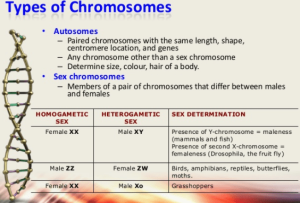What are the two Types of chromosomes?

In human beings, there are two main types of chromosomes, allosomes, and autosomes. There are 22 pairs of autosomes and one pair of allosomes in our genome, resulting in a total of 46 chromosomes. These are nucleoprotein bodies, which are dark-staining with basic dyes, microscopically observable in the cell during cell division. They carry the genes that are arranged in linear order. Each species has a characteristics chromosome number.
Example
Onion contains 16 chromosomes human beings contain 46 chromosomes. The chromosome s composed of DNA and basic protein, called hi stones, DNA and histone together form a structure called nucleoside.
The chromatin material! is formed by a series of repeating chromosomes, which are closely attached to each other to form a continuous fiber. Chromosomes wiÆimi1ar size, shape, and position of centromere arc said to be homologous Chromosomes.
CROSSING OVER
An exchange of segments between non-sister chromatids of homologous chromosomes occurs at chiasmata is known as crossing over.
Process of crossing over during meiosis
In synapsis during prophase-! of Meiosis-! the homologous chromosomes pair up lengthwise, point to point, and locus to locus. Each homolog consists of two sister chromatids with identical genes. Chamita or x-shaped crop links are formed by non-sister chromatids.
Significance of crossing over
Crossing over is very important as ii helps in the variations of genes. Actually during crossing over the exchange of genes takes place and this results in the formation of new combinations of genes (alleles).
So the resulting zygote would be an individual onc (of its own kind). This is because of crossing over that every individual in this world is somewhat different from Lh41 of others.
DNA
Deoxyribonucleic acid (DNA) is the chemical substance responsible for the transmission of hereditary information. In its structure information is coded for the synthesis of cell proteins
Structures’ of DNA
- DNA is long rope-like very complex molecule.
- The structural units of this molecule are called nucleotides.
- These nucleotides are joined together in a long chain called polynucleotides.
- It is composed of two strands, each wound around the other form double helix.
- Each Deoxyribonucleic is made up of three
components
- Deoxyribose sugar
- Phosphoric Acid
iii. Organic bases (Nitrogenous bases)
There arc four different types of organic bases.
- a) Adenine b)Thymine c) Guanine
- d) Cytosine
- Billions of this nucleotide combine to form a single molecule of DNA
- These molecules are joined in specific pairs (A-T G -C) with one another through phosphoric acid.
Replication of DN
Duplication of DNA is called replication. This process makes an exact copy of itself.
MECHANISM OF SELF REPLICATION
- Watson and Crick model of DNA ideally proposed the mechanism of self-replication.
- The hydrogen bonds (weak forces) that hold together the double helix of DNA are broken.
- Starting from the end, like a zip the double spiral gradually UNZIP along its length and each new nucleotide of the proper kind would be added to the separated chains.
- Through there steps a new upright would be supplied for each ladder.
- By the lime, the end of the spiral is reached and the two original strands of the DNA ill have separated each strand will have the nucleotide partners it has lost, substituted with new ones of exactly the same kind.
- Each newly formed daughter DAN molecule has one parental strand and one daughter strand in a double standard structure.